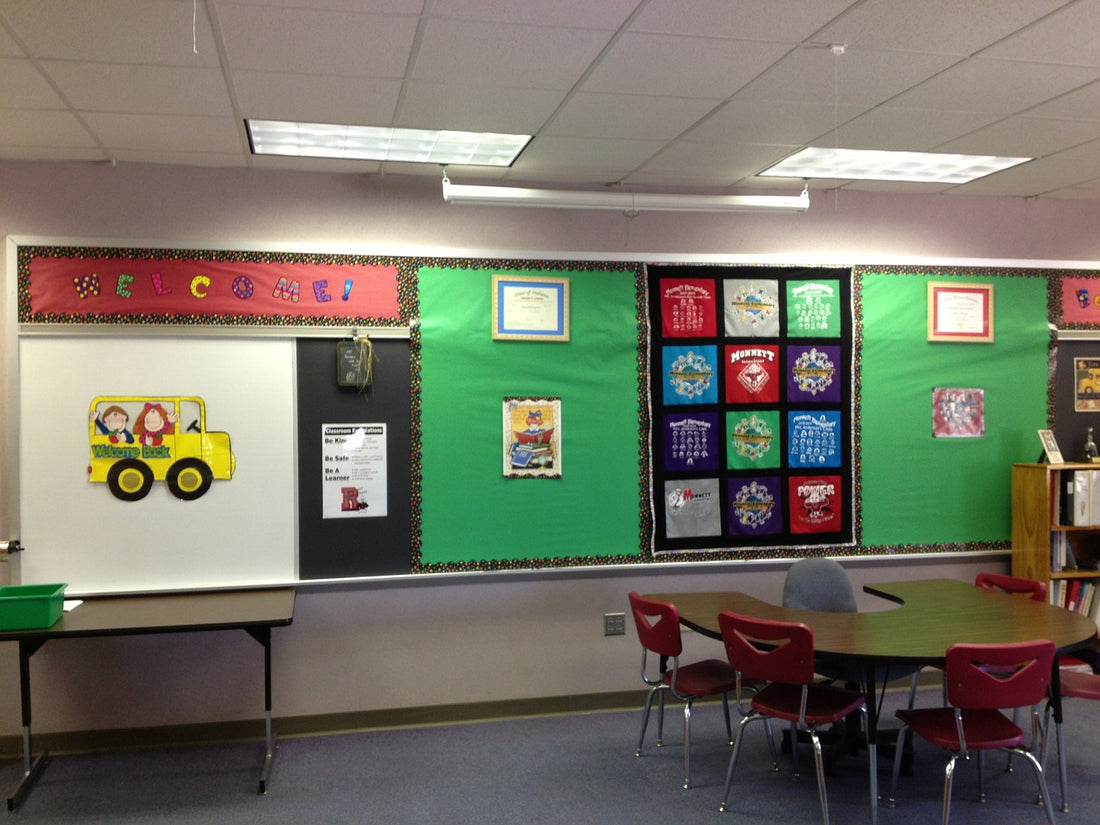I think there is a fine line between having representations of children's work up on the wall for them to feel like the class is their own and visual pollution.
Last year I went for PD at another school. The class was very well cared for and the teacher had obviously spent hours curating writing samples, artwork and centre signs.
However, I had a hard time concentrating on the speaker as I was looking around at the wall displays that went all the way to the top of the wall and were on the three walls I could see around me, not to mention the whiteboard which was full with labels and magnets.
If I was having a hard time concentrating, what about the children?
So where is the line between decorated and bare?
Where is the line between student voice through displays and visual pollution?
Where is the just right, Goldilocks zone?
Maybe my philosophy was wrong. I decided to dig a bit deeper.

Philosophy
Some of this comes down to your personal philosophy or the philosophy of the school you are at. Some people like colour and noise, some people like things muted. Some schools let teachers do whatever they want, some insist on having certain things in every class for the sake of shared values or unity.
Montessori philosophy believes the materials or equipment are the things that should "speak" to the child so the walls shouldn't crowd out the equipment that are laid out beautifully on the shelves. They prioritise a homelike atmosphere with natural light, artwork and plants. In my recent Montessori classroom I have encouraged students to put things up on the wall that are important to them, when they want.
Steiner classrooms also prioritise a natural enviornment, while Reggio Emillia classrooms think displays should trace the progression of a child's work.
I have been in mainstream classrooms where all classrooms are expected to have a certain thing on display for example a spelling poster linked to the school's spelling programme or a wall display about the Inquiry topic as the school believes these are important to student learning. In one school I relieved in each of the five year one classes had a four wall, near identical freize of the history of the city they lived in around them - well above head height of the children.
Student Outcomes
in NZ we have been encouraged to prioritise making our classrooms welcoming to all learners and having plentiful displays of student work so students feel encouraged and at home in the classroom. I have even experienced ERO reviews where ERO correlates examples of student work on the wall as evidence of student outcomes.
Do decorated rooms or bare rooms affect student outcomes.
Yes.
Both overly decorated rooms and rooms that are bare and boring both negatively impact student learning.
There are definitely other ways of making our classrooms welcoming and also improving student outcomes.
So what does help kids?
As educators, of whatever philosophy, we all aspire to help students have the best learning outcome they can, many of us use wall displays to help with this and spend our own hours and money creating displays and making the classroom "just right."
Research shows, like lots of things, the truth is somewhere in the middle. Neither classrooms that are bare and boring or overly cluttered with displays of work, art and anchor charts are great for learners.
These things definitely help student learning:
- Co-constructed learning posters or anchor charts.
- Places for the eye to rest
- Natural Light
- Classroom design (student ownership e.g. artwork, photos) and the architecture of the classroom such as the shape of the classroom.
- Ordered displays
- Well defined learning areas
- Air Quality and Temperature
These things have been shown to not help student learning:
- Studies have shown that commercial bought charts e.g. spelling rule charts, characteristics of a good learner, value charts etc do not engage students in their learning and can be a distraction to what the student is meant to be concentrating on.
- Clutter - e.g. so many pictures and displays on the wall there is no blank space, or space for the eyes to rest, the space is "noisy."
- Poor quality electrical light.
Some of these things we can have very little control over e.g. lighting, classroom shape or the temperature of the classroom. We can though control the presentation of our classrooms and make sure they are in the "Goldilocks Zone" with displays that are relevant, uncluttered, and co-constructed. Our walls also need to allow places for the eye to rest, our displays also need to be in places that will not distract students especially when they are meant to be listening to the teacher.
